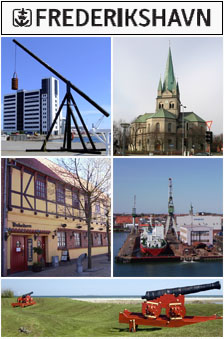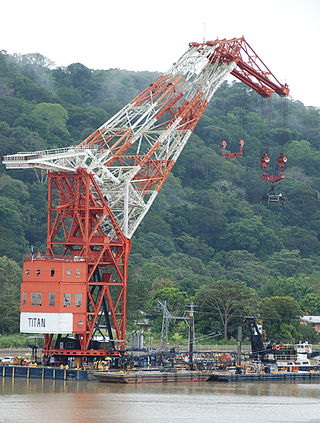
Transport in Denmark is developed and modern. The motorway network covers 1,111 km while the railway network totals 2,667 km of operational track. The Great Belt Fixed Link connecting the islands of Zealand and Funen and the New Little Belt Bridge connecting Funen and Jutland greatly improved the traffic flow across the country on both motorways and rail. The two largest airports of Copenhagen and Billund provide a variety of domestic and international connections, while ferries provide services to the Faroe Islands, Greenland, Iceland, Germany, Sweden, and Norway, as well as domestic routes servicing most Danish islands.

Frederikshavn is a Danish town in Frederikshavn municipality, Region Nordjylland, on the northeast coast of the Jutland peninsula in northern Denmark. Its name translates to "Frederik's harbor". It was originally named Fladstrand.

A shipyard, also called a dockyard or boatyard, is a place where ships are built and repaired. These can be yachts, military vessels, cruise liners or other cargo or passenger ships. Compared to shipyards, which are sometimes more involved with original construction, dockyards are sometimes more linked with maintenance and basing activities. The terms are routinely used interchangeably, in part because the evolution of dockyards and shipyards has often caused them to change or merge roles.

The Long Beach Naval Shipyard, which closed in 1997, was located on Terminal Island between the city of Long Beach and the San Pedro district of Los Angeles, approximately 23 miles south of the Los Angeles International Airport. The primary role of NSY Long Beach at the time of its closure was overhaul and maintenance of conventionally-powered US Navy surface ships, but it also had served as the homeport for several auxiliary ships during its operating history.

BLRT Western Shipyard is a shipyard in Klaipėda, Lithuania. The company belongs to the Estonian company BLRT Grupp and provides shipbuilding and repair services in the Baltic region.

Titan Clydebank, more commonly known as the Titan Crane is a 150-foot-high (46 m) cantilever crane at Clydebank, West Dunbartonshire, Scotland. It was designed to be used in the lifting of heavy equipment, such as engines and boilers, during the fitting-out of battleships and ocean liners at the John Brown & Company shipyard. It was also the world's first electrically powered cantilever crane, and the largest crane of its type at the time of its completion.
The Morse Dry Dock and Repair Company was a major late 19th/early 20th century ship repair and conversion facility located in New York City. Begun in the 1880s as a small shipsmithing business known as the Morse Iron Works, the company grew to be one of America's largest ship repair and refit facilities, at one time owning the world's largest floating dry dock.

Severnaya Verf is a major shipyard on Gutuevsky Island in Saint Petersburg, Russia, producing naval and civilian ships. It was founded as a branch of the Putilov Plant in the late 1800s. Under the Soviets, the shipyard was generally known as Shipyard No. 190 and reverted to its former name in 1989.

Pegasus VIII is a yacht originally built for Carlos Peralta, head of lusacell. The yacht was ordered in 2002 at the Danyard A/S Frederikshavn shipyard in Denmark. One year later Princess Mariana was delivered by Royal Denship. In 2006 she was the 33rd largest yacht in the world.
Aalborg Shipyard was a shipyard located in Aalborg, Denmark.
The Inebolu Shipyard is located on Turkey's Black Sea coast in the town of Inebolu, Kastamonu Province. It is Turkey's only shipyard on the Black Sea. It operates a floating dock with a 4,500 ton lifting capacity, which can handle about 12.000 dwt vessels.
Odessos Shiprepair Yard is situated at the southern end of the city of Varna, Bulgaria, on the island between the old and new canals connecting the Black Sea and the Lake of Varna and is about one mile far from the mouth of Port Varna. Spread over an area of about 320,000 square meters, Odessos is the largest well-equipped yard in Bulgaria suitable for repair and drydocking of vessels up to 35,000 DWT and afloat repairs of vessels up to 150,000 DWT. Odessos Shiprepair Yard is the most busiest yard in the Black Sea.

Titan, better known by its former nickname Herman the German, is a large floating crane currently serving in the Panama Canal performing heavy lifts for lock maintenance. Prior to its move to Panama in 1996, the crane was based at the Long Beach Naval Shipyard from the end of World War II until the yard's closure in 1995. It was seized from the German Kriegsmarine following the end of World War II as part of war reparations. The crane was built by Demag Cranes AG as Schwimmkran nr. 1 in 1941 for the Kriegsmarine, where it had served in the Baltic Sea tending German U-boats. MMSI number: 374940000

An auxiliary floating drydock is a type of US Navy auxiliary floating dry dock. Floating dry docks are able to submerge underwater and to be placed under a ship in need of repair below the water line. Water is then pumped out of the floating dry dock, raising the ship out of the water. The ship becomes blocked on the deck of the floating dry dock for repair. Most floating dry docks have no engine and are towed by tugboats to their destinations. Floating dry docks come in different sizes to accommodate varying ship sizes, while large floating dry docks come in sections and can be combined to increase their size and lift power. Ballast pontoon tanks are flooded with water to submerge or pumped dry to raise the ship.

USS AFDM-2,, is an AFDM-3-class medium auxiliary floating drydock built in Mobile, Alabama by the Alabama Drydock and Shipbuilding Company for the U.S. Navy. Originally named USS YFD-4, Yard Floating Dock-4, she operated by Todd Shipyards at New Orleans, Louisiana for the repair of US ships during World War II. YFD-4 was renamed an Auxiliary Floating Dock Medium AFDM-2 in 1945 after the war.
Everett-Pacific Shipbuilding & Dry Dock Company was established in 1942 to build ships needed for World War II. Yard construction began on 1 March 1942. As part of the Emergency Shipbuilding Program, the US Navy provided some of the capital to start Everett-Pacific Shipbuilding at Port Gardner Bay in Everett, Washington. Everett-Pacific was sold in 1945 to the Pacific Car and Foundry, who was already a major manufacturer of railcars and trucks. Pacific Car and Foundry was building barges for the US Navy during World War II at plants in Renton, Seattle and Tacoma in the state of Washington. The lease for the shipyard in Everett, Washington ended in 1949 and the yard closed. Pacific Car and Foundry in 1972 changed its name to Paccar Inc. to reflect its major products. The Everett-Pacific shipyard site later became part of Western Gear, a heavy machinery manufacturer. From 1987 to 1992, the shipyard was rebuilt to become part of Naval Station Everett. Everett-Pacific Shipbuilding was started by William Pigott Jr. a Seattle businessmen and his brother Paul Pigott (1900-1961). William Pigott Jr. was born in 26 Aug. 1895 in Pueblo, CO and died on 8 July 1947 in San Francisco, CA.
Pollock-Stockton Shipbuilding Company was established in 1942 to build ships needed for World War II. As part of the Emergency Shipbuilding Program the US Navy provided some of the capital to start Pollock-Stockton Shipbuilding at Stockton, California. The shipyard was located at San Joaquin River and Stockton Channel, near Louis Park. After the war the shipyard closed down in February 1946.

Quentin Durward was a paddle-wheel steamer, built in the United Kingdom in 1823. The ship was bought in 1827 by a Danish businessman and was employed on a route between Copenhagen and ports in Jutland and Funen, with the name Dania. She later served on the route between Aarhus and Kalundborg. The paddle-wheeler was broken up in 1841.

Bethlehem Sabine Shipyard, or Sabine Shipyard was a 223-acre shipyard of Bethlehem Steel in Port Arthur, Texas. The Bethlehem Shipbuilding Corporation's Sabine Shipyard opened in August 1985. The yard serviced offshore drilling rigs and ships. The Sabine Shipyard had a nation's largest floating drydock. Bethlehem purchased the United States Navy surplus drydock, USS ABSD-5 that was at Pearl Harbor, Hawaii. USS ABSD-5 seven-sections were tugged to the Sabine Yard arriving in December 1984. USS ABSD-5 has a lift capacity of 64,000 tons.












